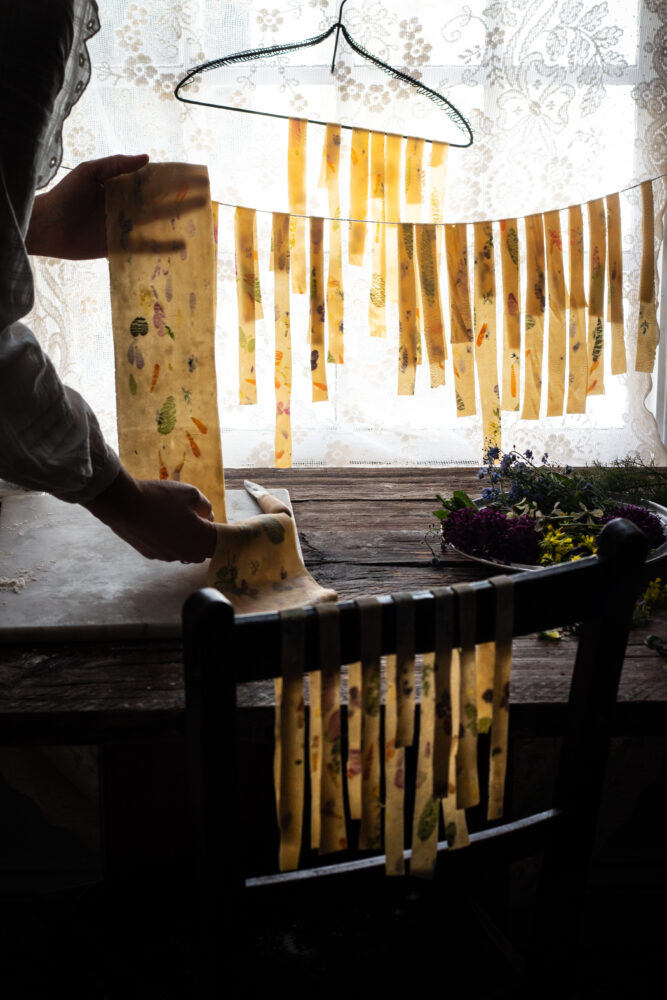
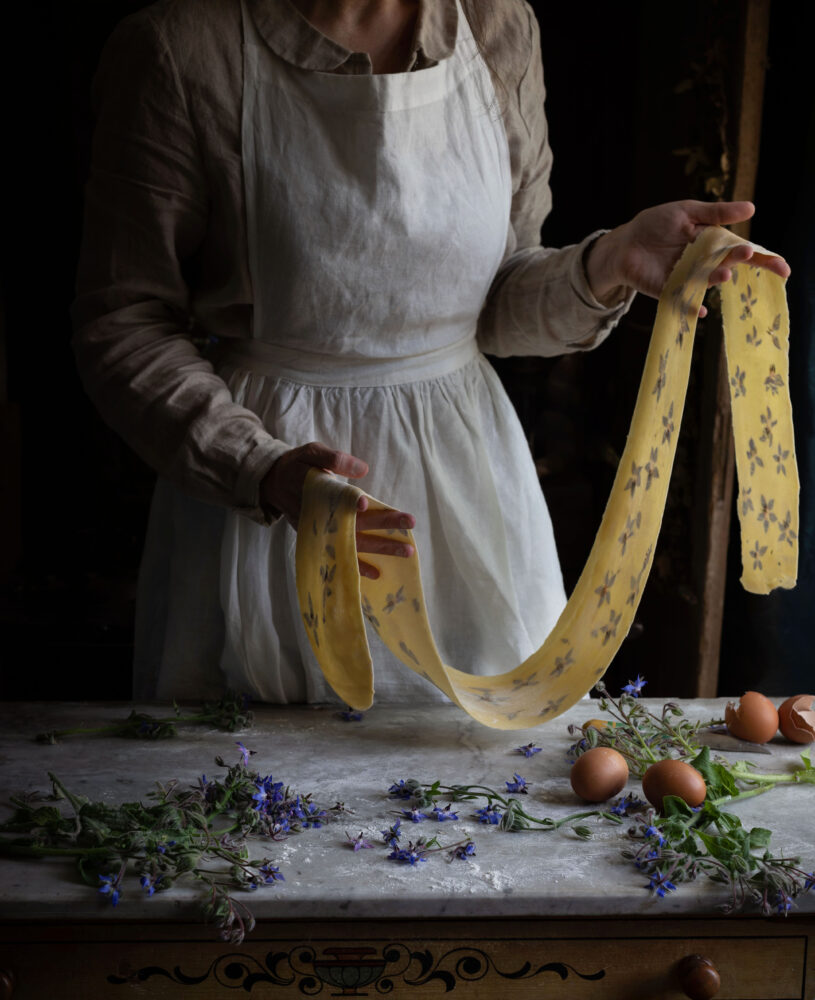
Edible flower pasta is made by laminating flowers or herb’s between two pieces of dough. Its an easy step that creates the most beautiful pasta, but that’s not all, the flowers and herbs can add flavour too.
I talked briefly about stained glass pasta on my in depth pasta blog post here, but I feel like it deserves a post all of its own. That way I can talk about which edible flowers and herbs work best and share some recipe suggestions with you.
If you are new to making pasta then i would love it if you go and check out that post first, as it gives you lots of tips on how to make the dough.
I love how the flowers look when you hold the pasta up to the light, they create a beautiful mosaic of colour like a painting.
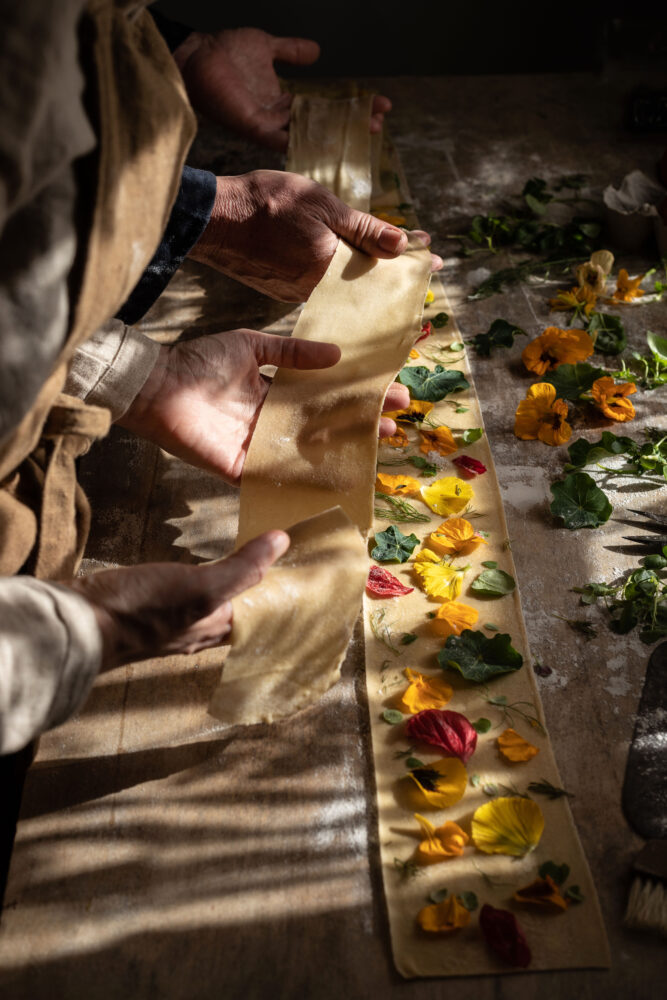
Pasta
I adore making pasta, it is such a fun process and adding the edible flowers or herbs to it just seem to make it that bit more enjoyable.
If you follow me on Instagram then you are probably used to me regularly swooning about pasta. I have developed a real love affair with it.
Adding two ingredients together; flour and eggs, and working it in to a dough and then rolling and shaping it into what ever pasta shape i fancy is so therapeutic.
If you have made pasta yourself, then i am quite confident that you know what i’m talking about. I think i could happily make it every day and not get bored of it.
To give you some inspiration on some dishes to use the edible flower pasta with, i have also included two delicious spring inspired recipes for you at the bottom of this post.
Jump to RecipeOne is ravioli filled with peas, new potato, mint and ricotta, and the other is a pappardelle with pea shoot and pistachio pesto. This pasta could be used with any pasta dish you want though.
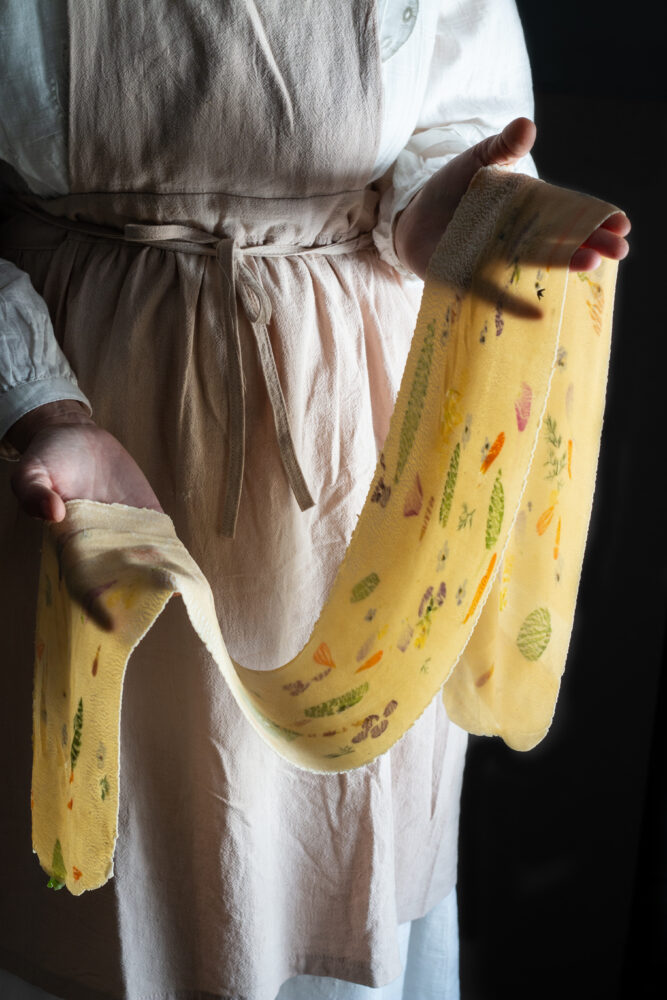
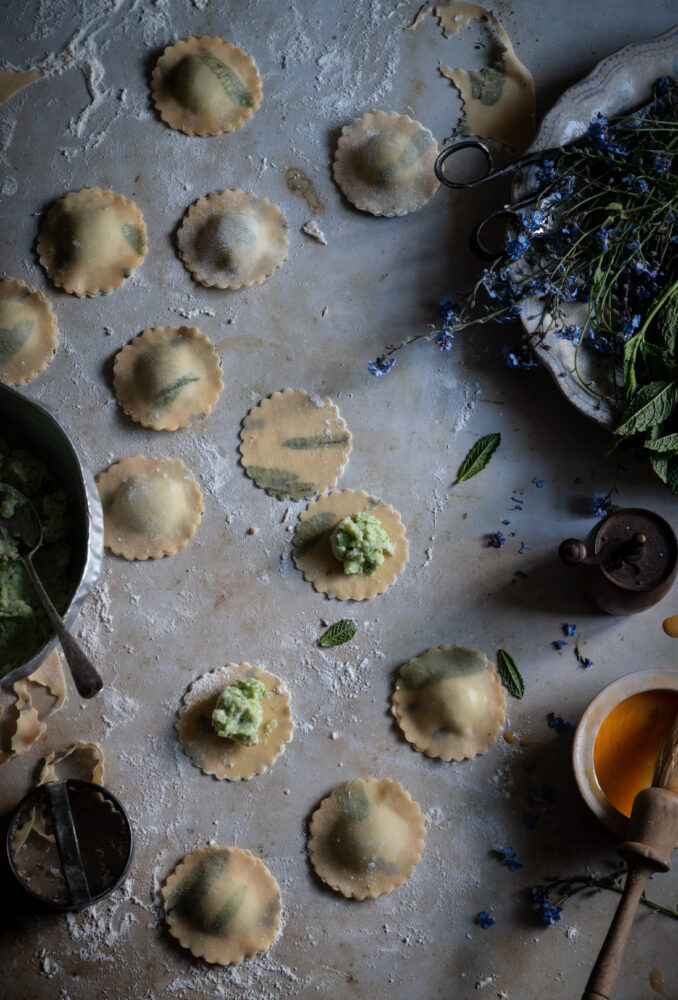
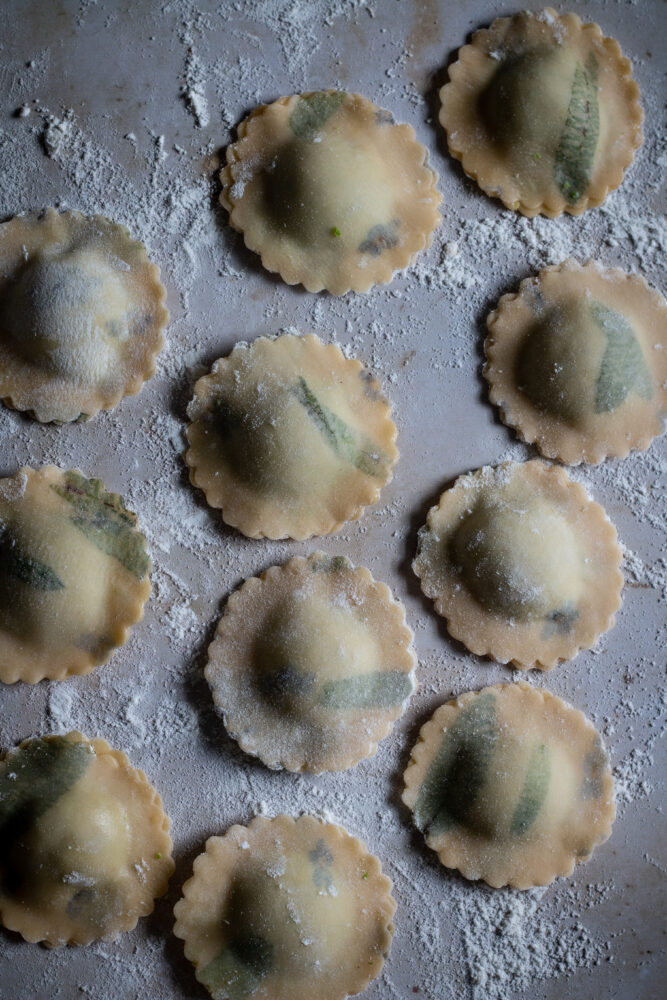
Choosing the herbs and flowers for your edible flower pasta
You need to pick herbs and flowers that are thin and soft, so that they easily flatten when rolled through the pasta machine. Woody herbs like rosemary won’t work for this. This is because the hard leaves would tear the dough. You will get the best results by using the thinnest softest herbs you can. Basil is probably the easiest herb to use as it’s thin and the flavour pairs well with most Italian dishes. I really love to use small young mint leaves too.
Herbs that work
- Mint
- Basil
- Tarragon
- Dill
- Parsley
- Oregano
- Marjoram
- Some sage varieties – there are several varieties of sage that are thin, but the normal every day sage is quite thick and will tear the dough.
- Some thin varieties of thyme if you remove all the stems and keep the soft leaves.
- Chives – the tops of chives are thinner than the bottoms so i would suggest just using the ends.
Remove the stems so you just have the soft leafy part of the herb, i would suggest using the smaller younger leaves as they will be softer. When you roll them through the machine they will stretch and get larger.
Leafy greens
You can also use greens and leaves, these have flavour and work really well. Use thin small leaves and remove any stems.
- Spinach
- Rocket
- Fennel fond tops
- Small nettles
- Chervil
- Small nasturtium leaves
- Sweet cicely
- Micro herbs
- small nasturtium
- garlic mustard leaves
- small leafy greens
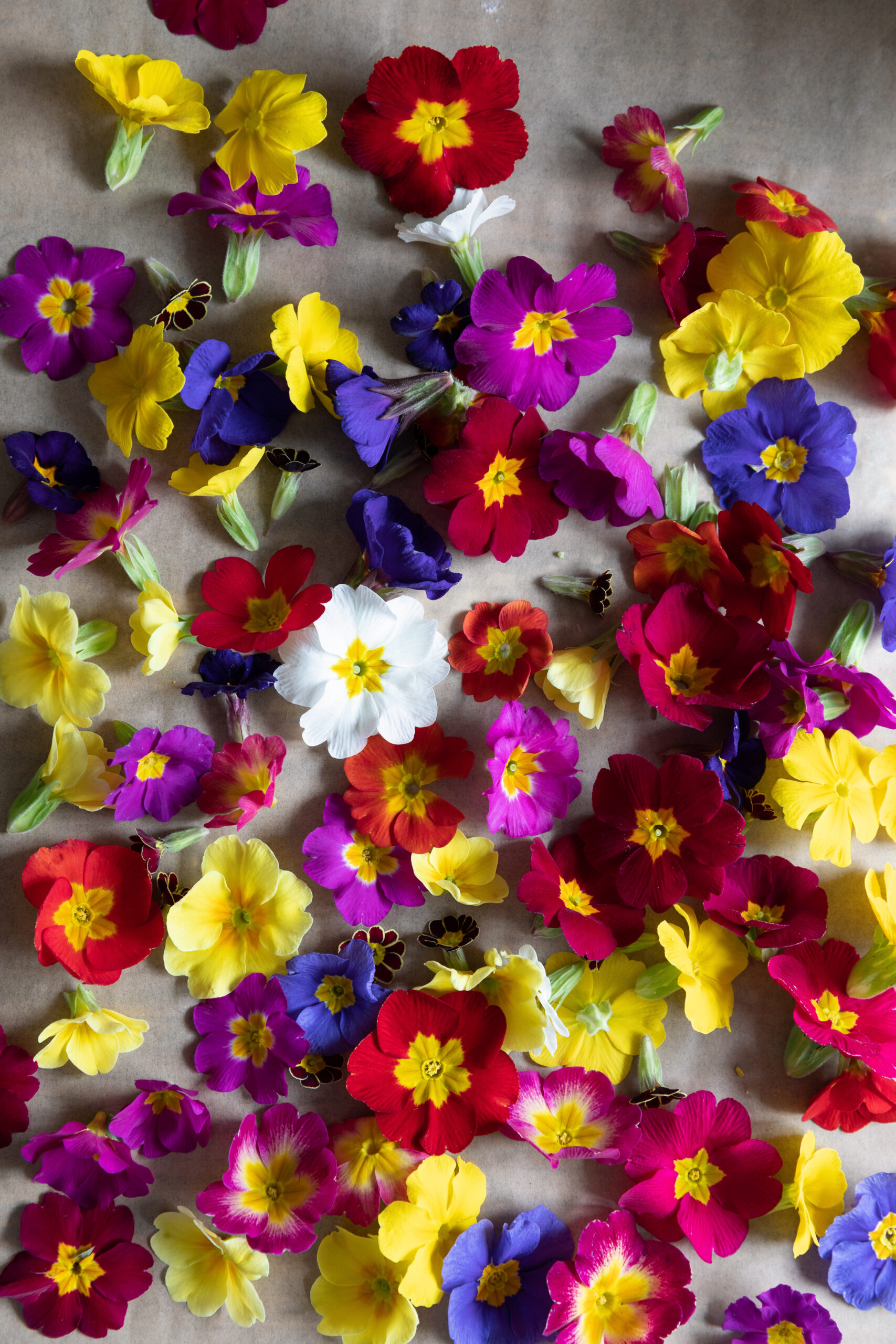
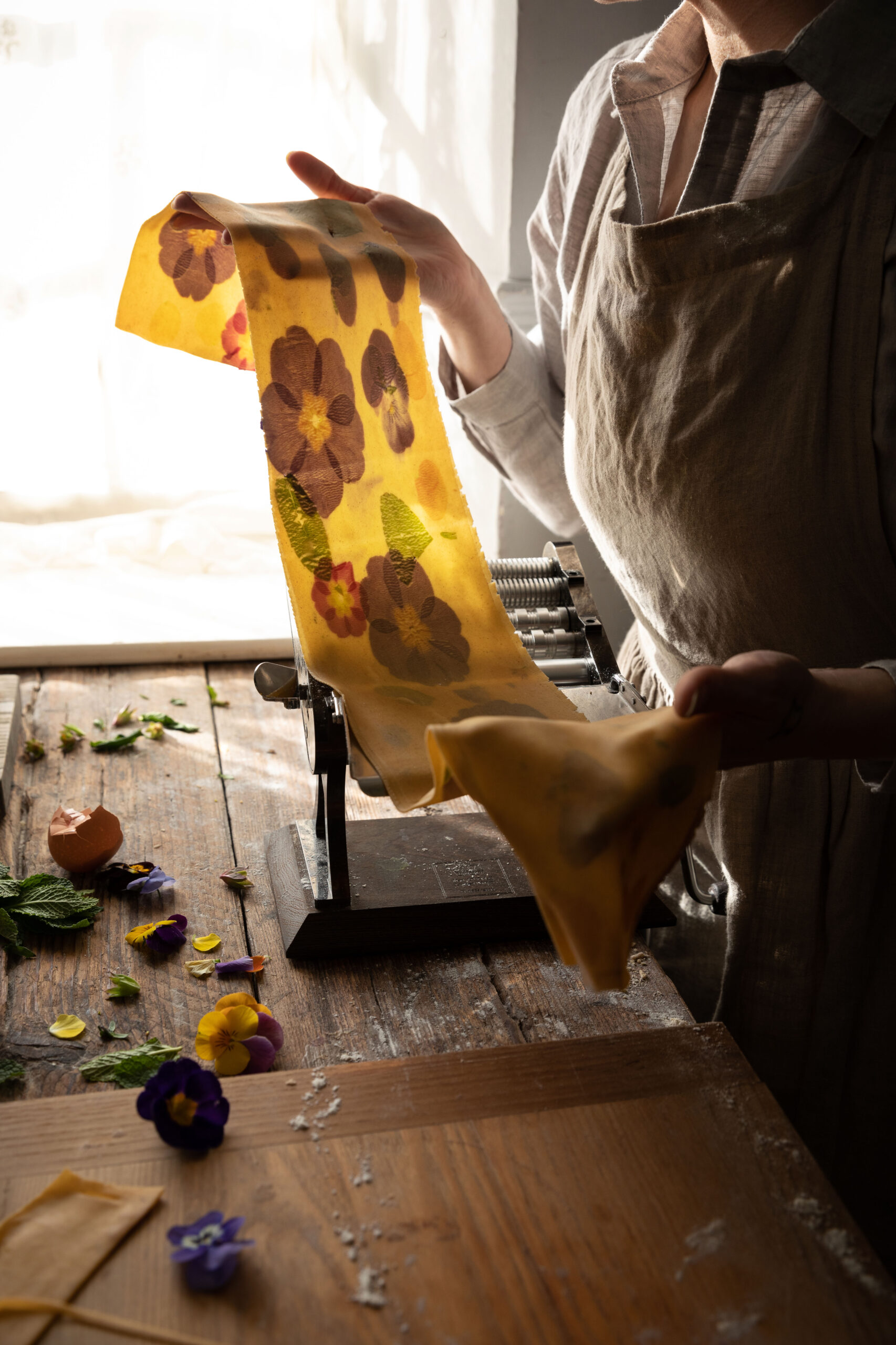
Edible flowers
I have separated the edible flowers that work well into two groups, the ones that have flavour, and the ones that don’t have any real flavour but work well for adding colour.
There are so many varieties of edible flowers, so i have missed some off this list. These are a selection that i feel work well. The same rule as with the herbs, remove all the stalks, and use the petals and not the centre parts of the flower. The centre parts of some flowers are quite hard and could tear the dough.
However you can keep some small thin flowers whole if you carefully remove the back so they are flat, like pansy or viola.
Ensure that any edible flowers that you use are organic and not sprayed with any chemicals. If you don’t have a garden or anywhere to forage for them then you can buy them.
Here in England there are several places to order edible flowers from, my favourite is Maddocks farm organics. Jan who owns the farm has a great list of edible flowers with photos to help you identify them here.
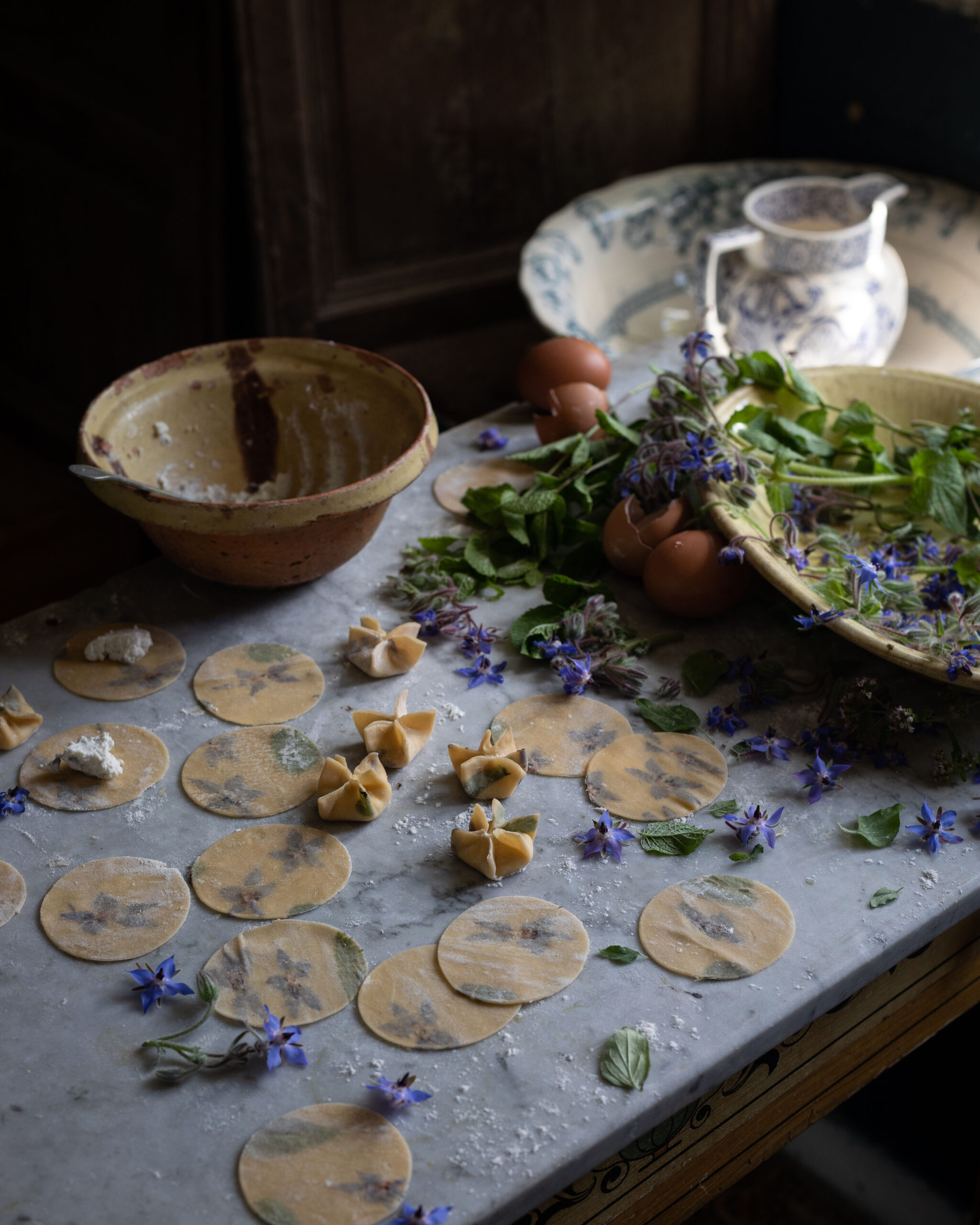
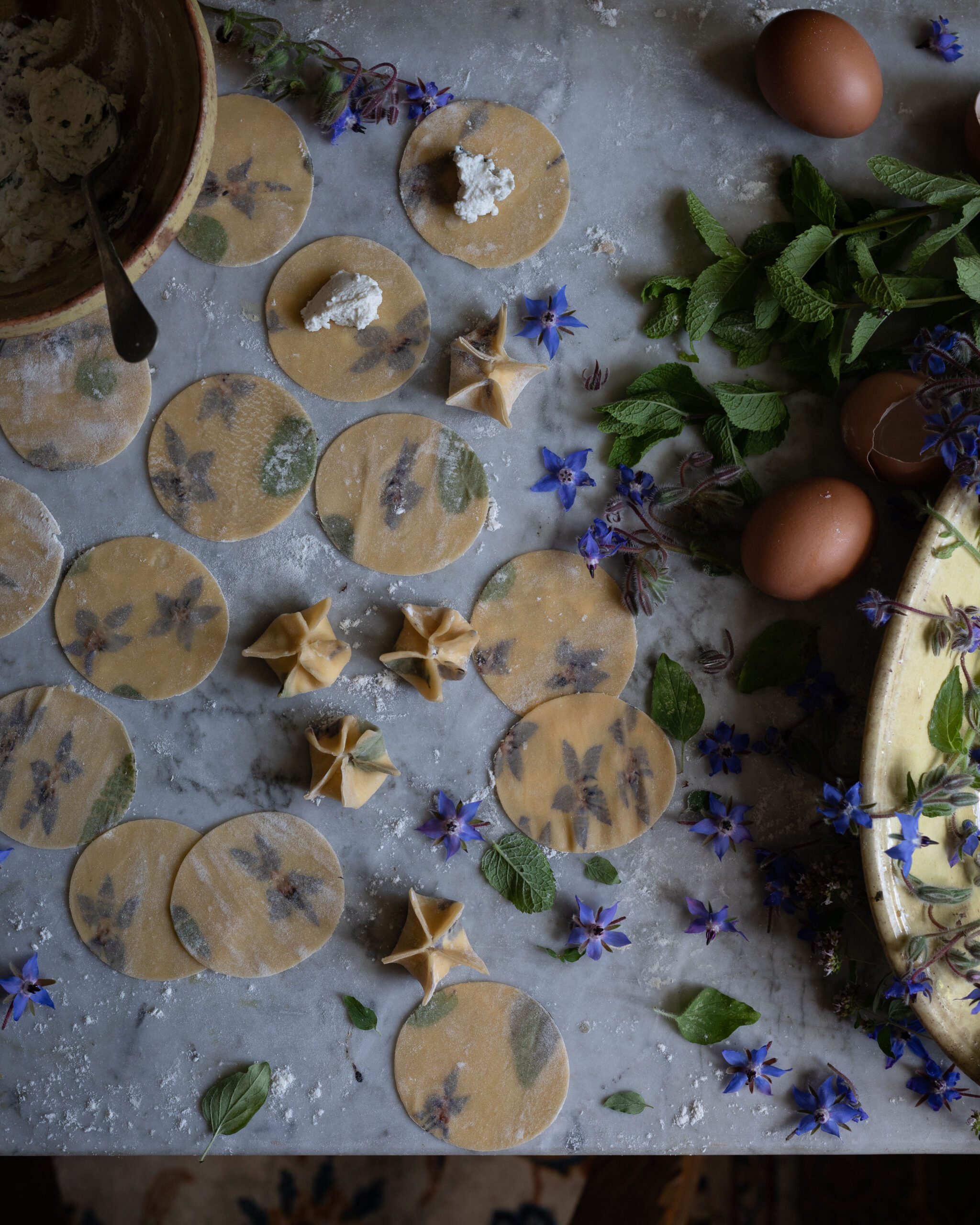
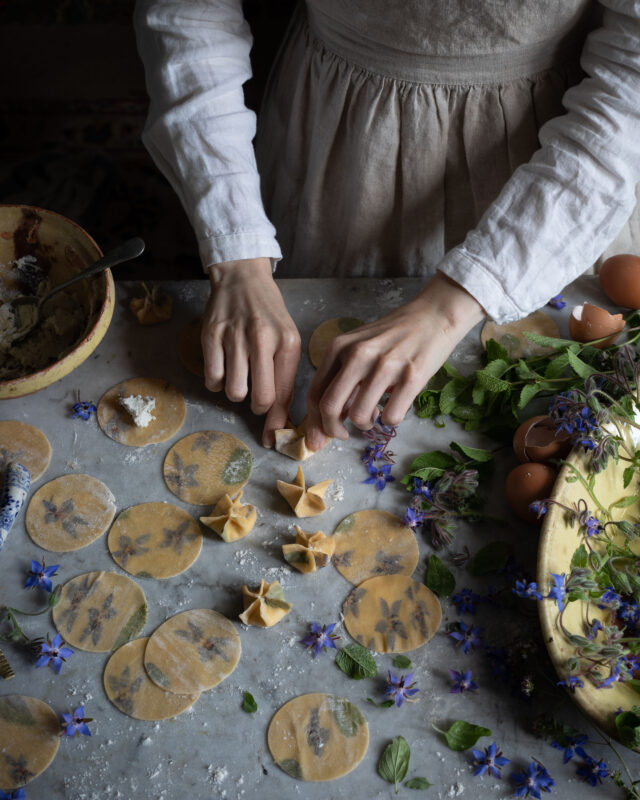
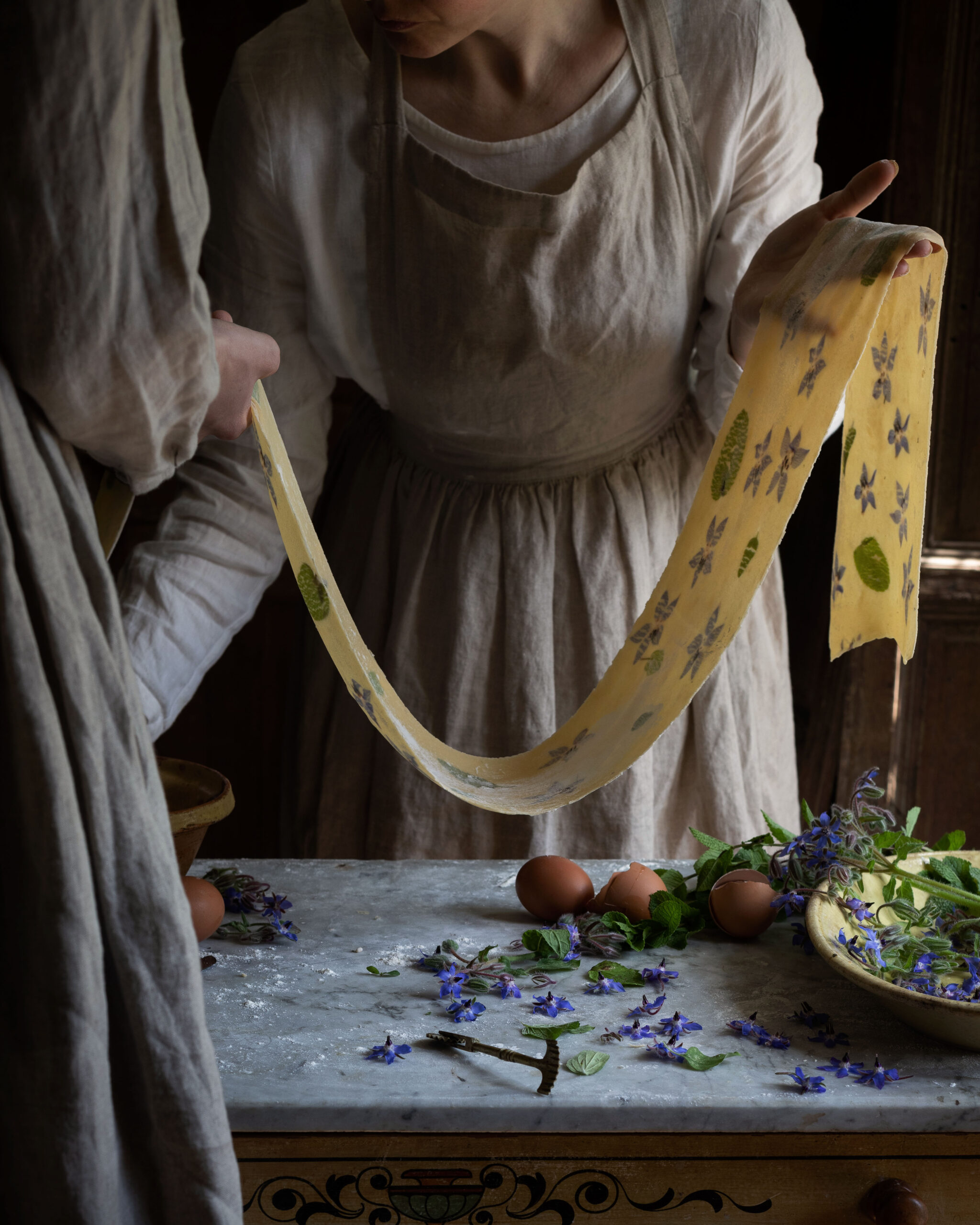
Edible flowers with flavour
- Mustard flowers – these have a slight spicy flavour
- Rocket flowers – these have a great spicy flavour
- Alliums like chive flowers have an onion like flavour
- Nasturtium – these have a spicy flavour
- Borrage- these flowers have a subtle cucumber like taste
- calendulas – mild spicy flavour with a nutmeg like taste
- Herb flowers – like rosemary, chive, thyme have a flavour that faintly resemble the herb its self so they work well.
- primula – these have a sweet taste and work well in baking but they are colourful so would mix well with more savoury tasting flowers for pasta
- Tagetes- these have a orange like taste
- Primroses – sweet flavour (these can be left whole if you cut the back off)
- Sunflower – these have a slight nutty flavour
- Dianthus – these flowers have a sweet taste and may work better in desserts, but it is quite subtle so they are a great addition for colour.
- Broad bean flowers- these have flavour but the white and black colour might not show up very well in the dough.
- Chicory- these flowers have a bitter taste, and come in a few different colours
- wild rocket flowers, these have a bright yellow colour.
Edible flowers for colour that don’t have a lot of flavour
These flowers are perfect for pasta but have little flavour, and are great for introducing colour.
- Cornflower petals (pluck the petals off)
- Cosmos – these are mild in flavour a little like lettuce
- Violas
- Forget me not’s (these can be left whole if you carefully remove the flower from the stem part)
- Primula
- Phlox
- Pansy’s
For further reading on edible flowers here is a great page to see more about them.
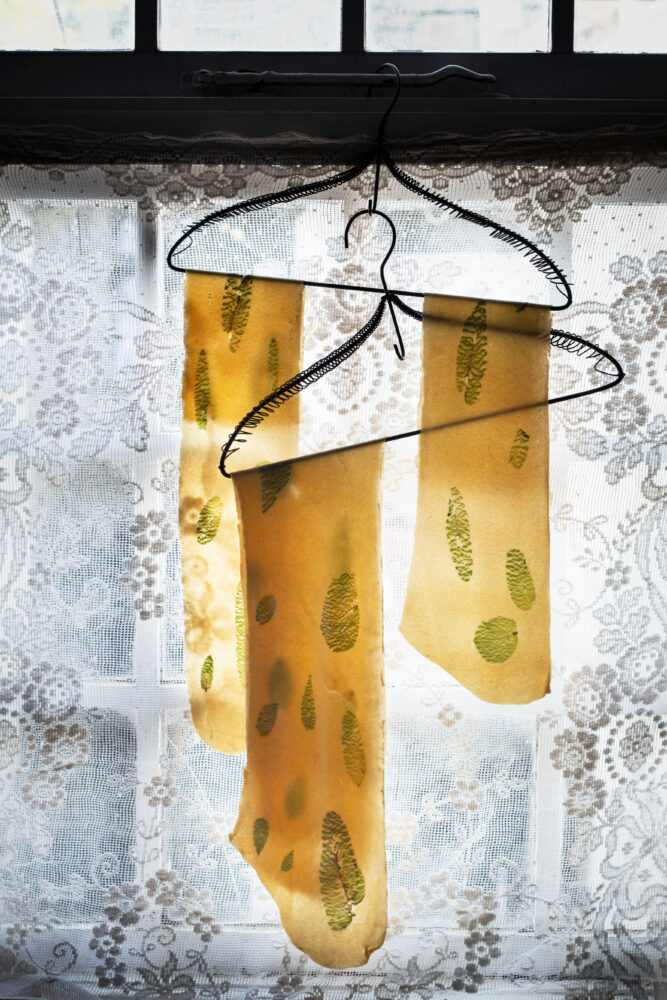
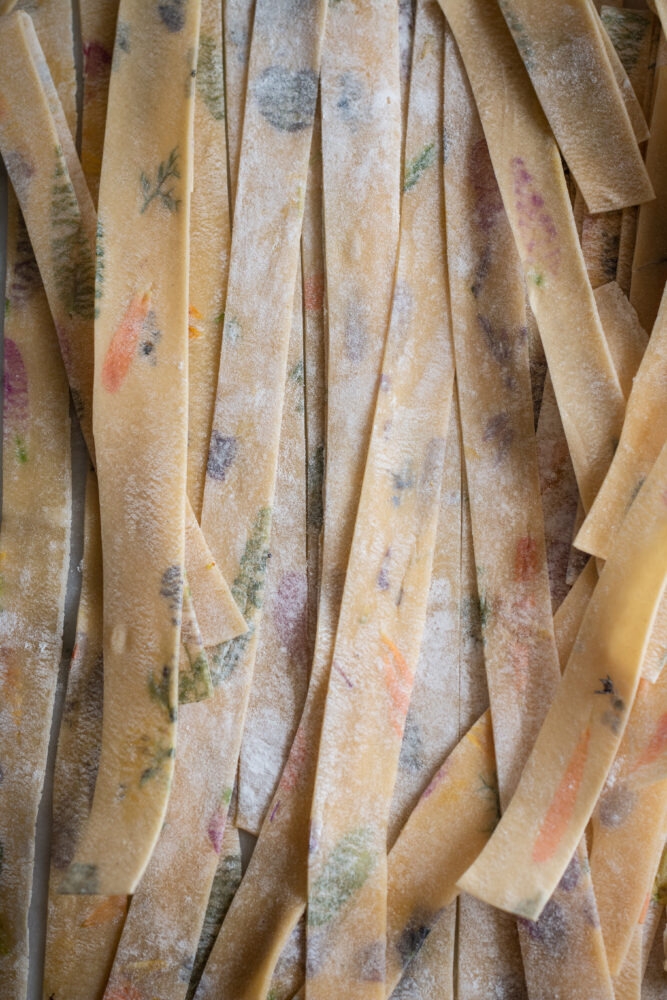
Making the dough
To make it, sift the flour on the table into a mound, and using your hands make a well in the centre so it is like a little volcano. Then crack the eggs into the centre and with a fork start mixing the eggs.
Mix it until a paste is formed then start bringing in a bit of flour from around the edge a little at a time until its combined, then use your hands to mix the rest and knead it into a ball. You can add more flour if the dough is too sticky or a few drops of water if it’s too dry.
Knead the dough with clean dry hands using the heel of your hand, basically as you would with bread. Working the dough for about 10 minutes until it is smooth to touch and elastic.
You can even knead it with the dough hook on your kitchen aid mixer if you are feeling really overwhelmed by the process of making it by hand, but I would suggest you try the hand mixed/kneaded method at least once or twice first so you can get used to how the pasta should look and feel.
Rest your dough!! You just mixed two completely different ingredients together and kneaded it into submission, give it time to rest and let it figure out it now has a totally different structure then it did 10 minutes ago.
Cover the dough in plastic wrap and leave to rest for at least half an hour. If you try to roll it straight away it will tear and not roll out smoothly.
Rolling the dough
Start with the machine on its widest setting, cut your ball of dough into four pieces. Cover the rest of the dough while you’re working so it doesn’t dry out.
Press the dough flat with your hand and sprinkle it with flour so it doesn’t stick, then roll through the machine, take the dough and fold in half and then roll through the machine again, I then fold the dough again and roll through.
I do this three times on the widest setting before I start to turn the width down to the next setting. This just ensures the dough will be silky smooth and an even width so its worth doing. The its ready to roll out with the pasta machine.
Put the dough through the machine turning down the setting each time until you reach a beautifully thin dough. I tend to go down to number 7 on my pasta machine but different machine models vary (it is one or two above the thinnest setting that my machine goes too). I roll it Even thinner for filled pasta.
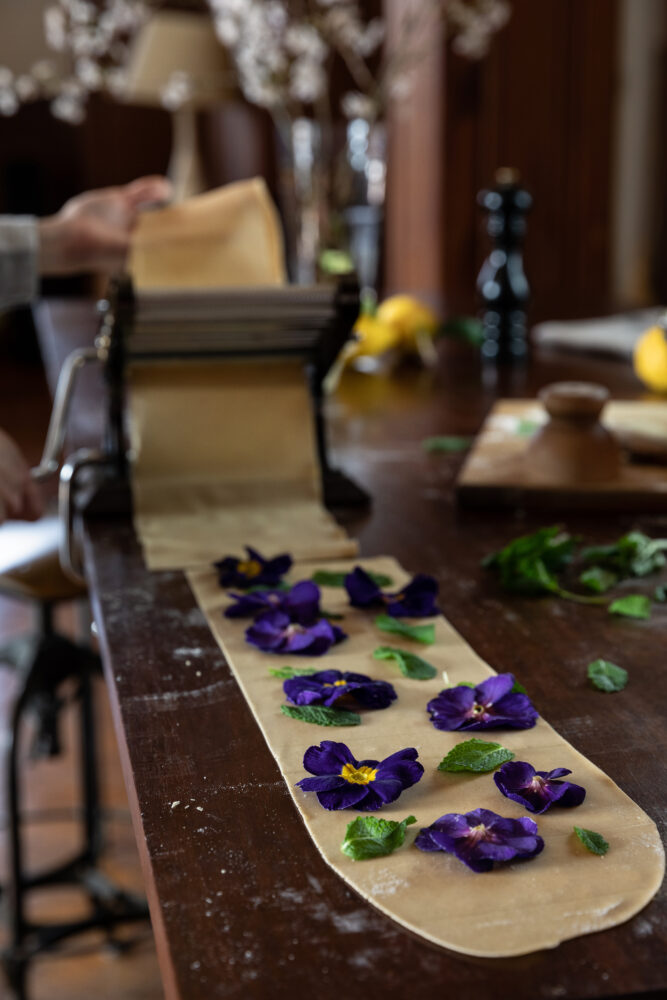
Adding the flowers and herbs
To do this, lay your sheet of dough out on the surface, if too long then cut in half. See photos below
Space the flowers and herbs out over half of the pasta sheet, remembering that they will stretch and change size and then fold the other half of dough over and press together.
Turn the pasta machine back up to two thicknesses wider than the one it was last rolled through before you added the herbs/flowers (number 5 on my machine) and roll the pasta through. Now turn it down to the next thickness and roll through again until it is nice and thin. The dough is now ready to be cut or shaped into any type of pasta you wish.
The herbs/flowers will break up and stretch with the pressure of being rolled so it can create some really amazing looking pasta. I love to use this type of pasta for ravioli and pappardelle so you can see the beautiful pattern.
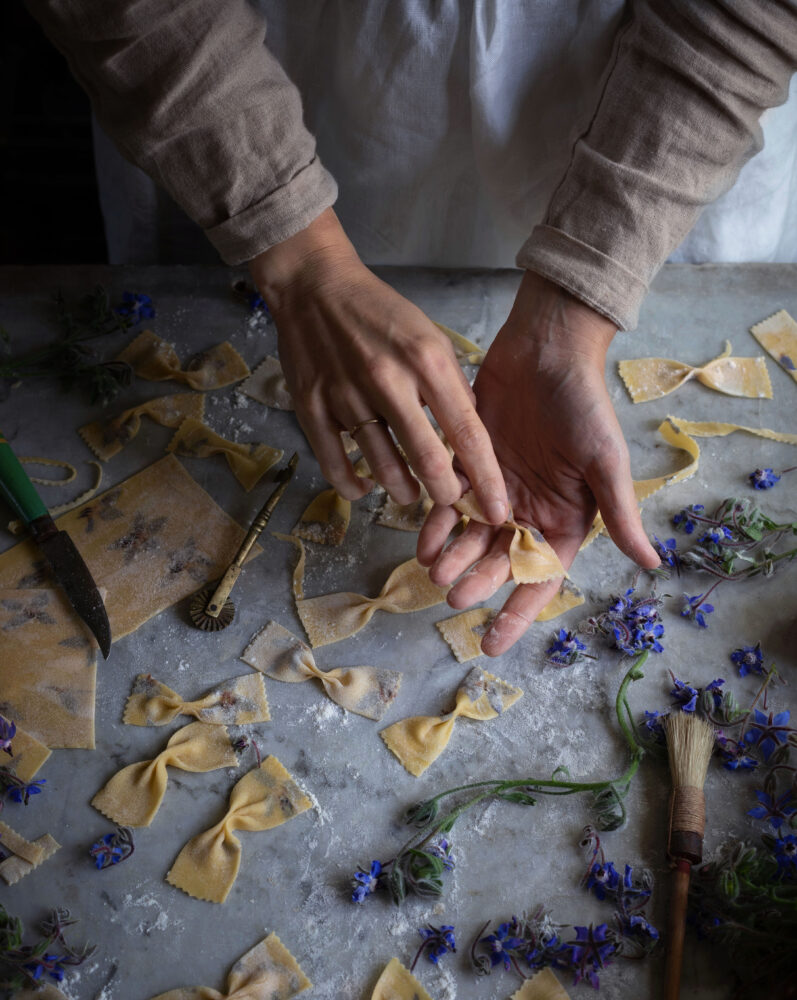
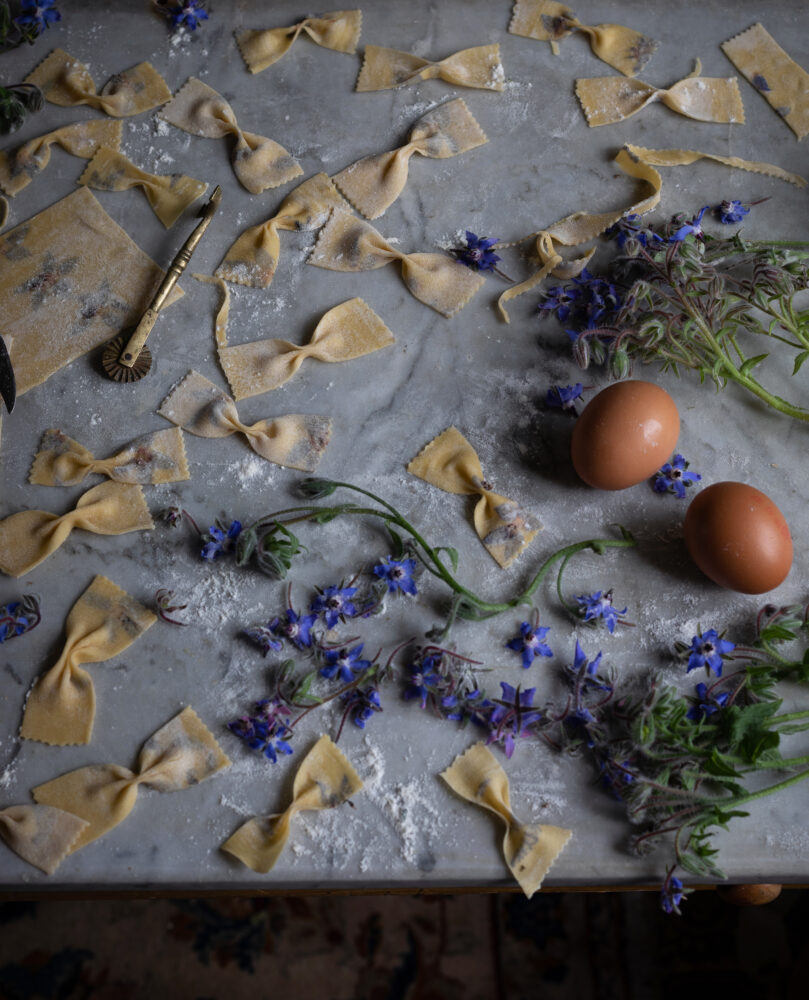
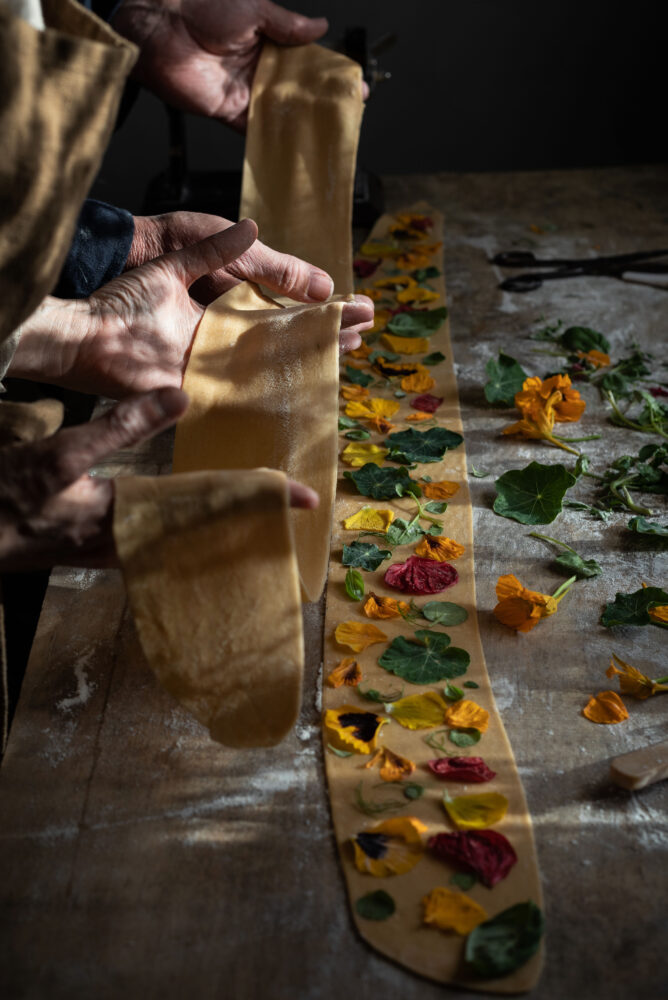
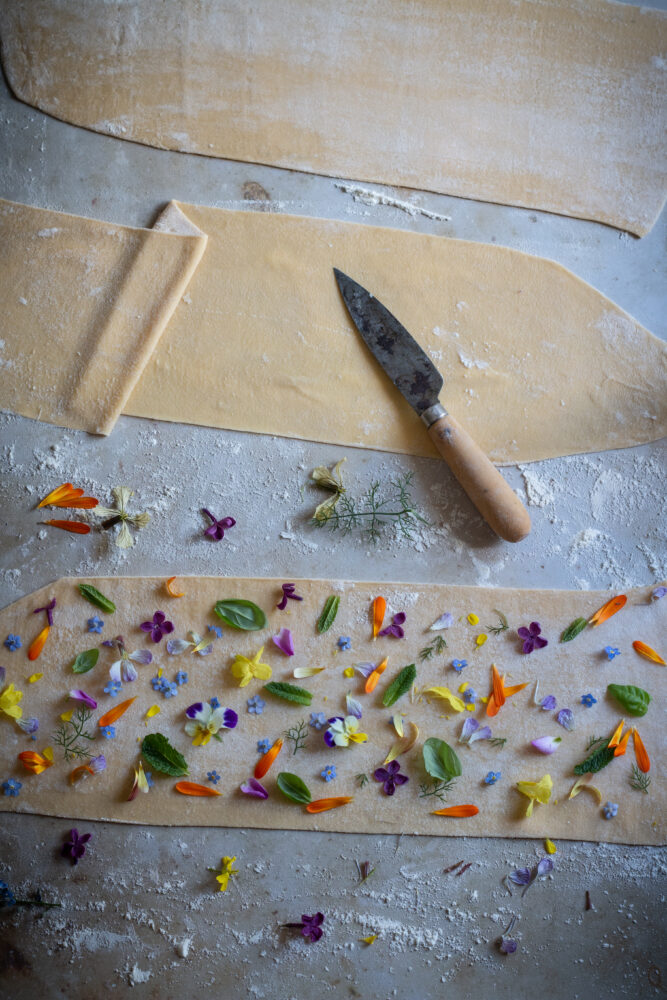
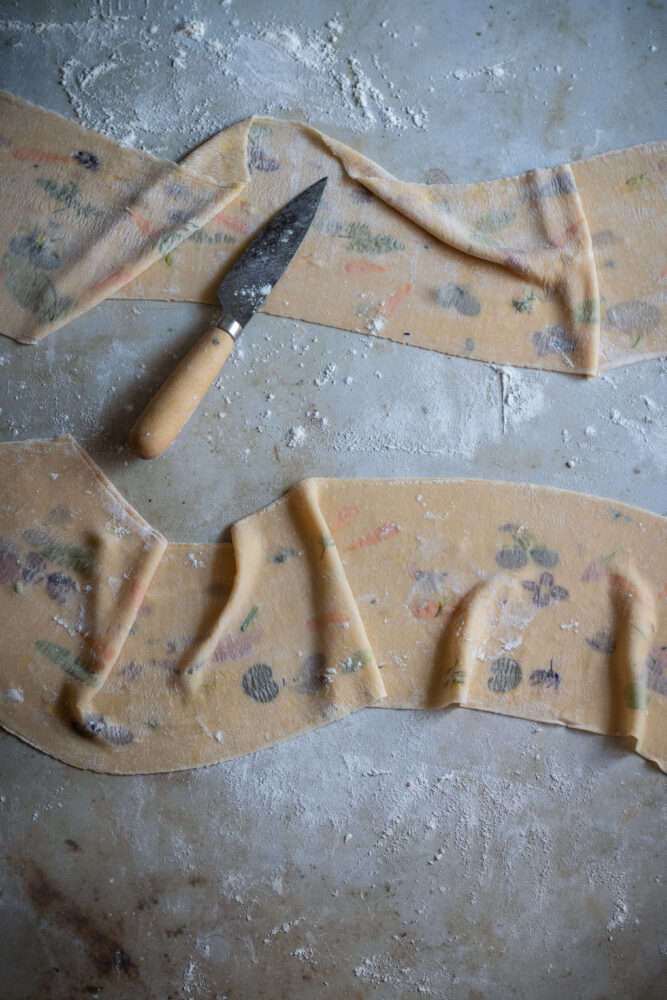
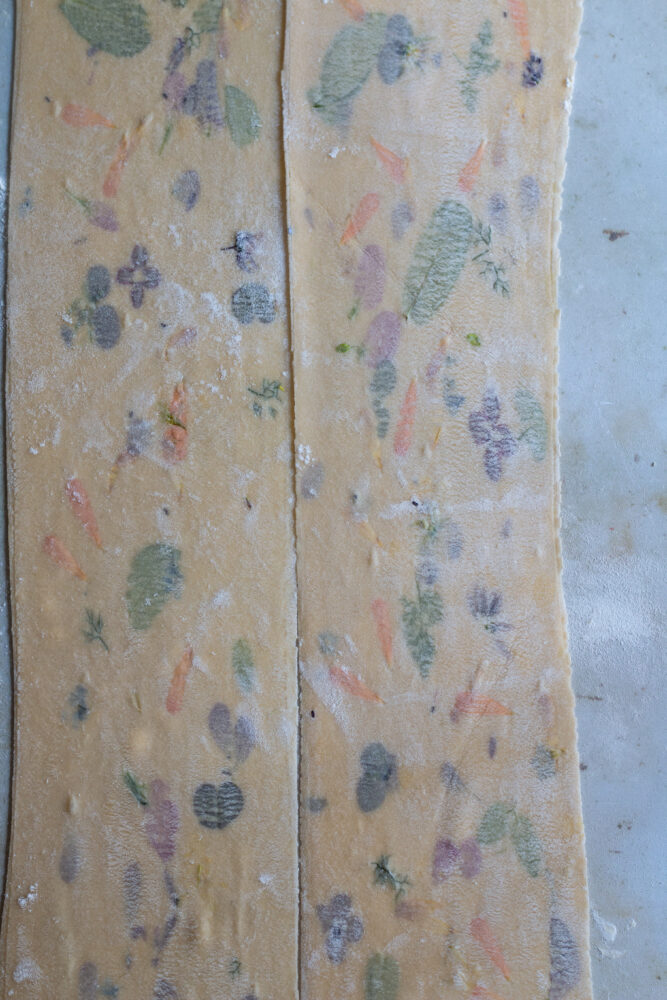
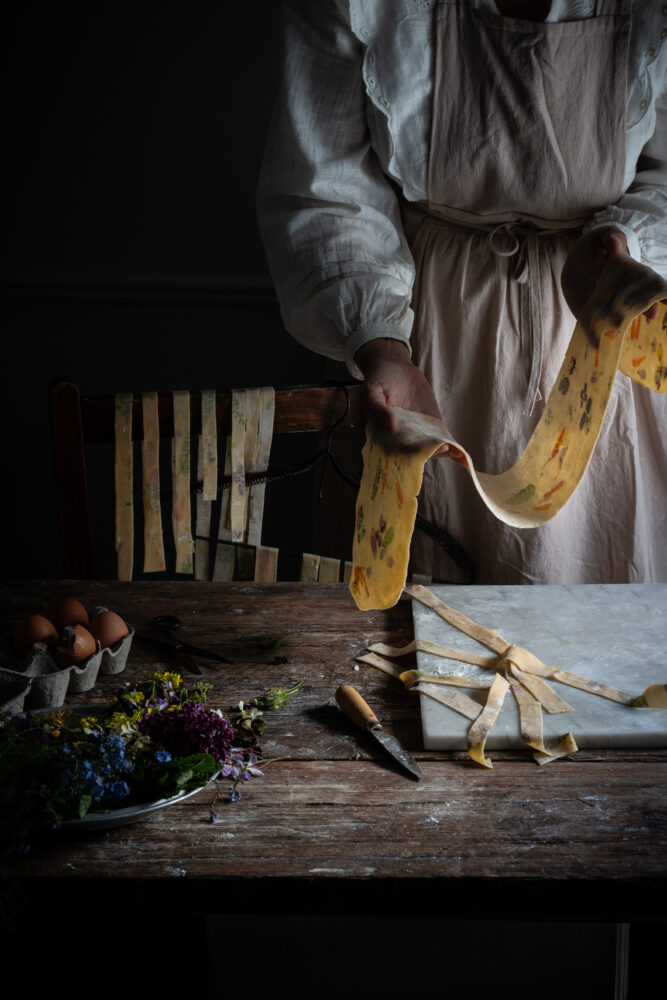

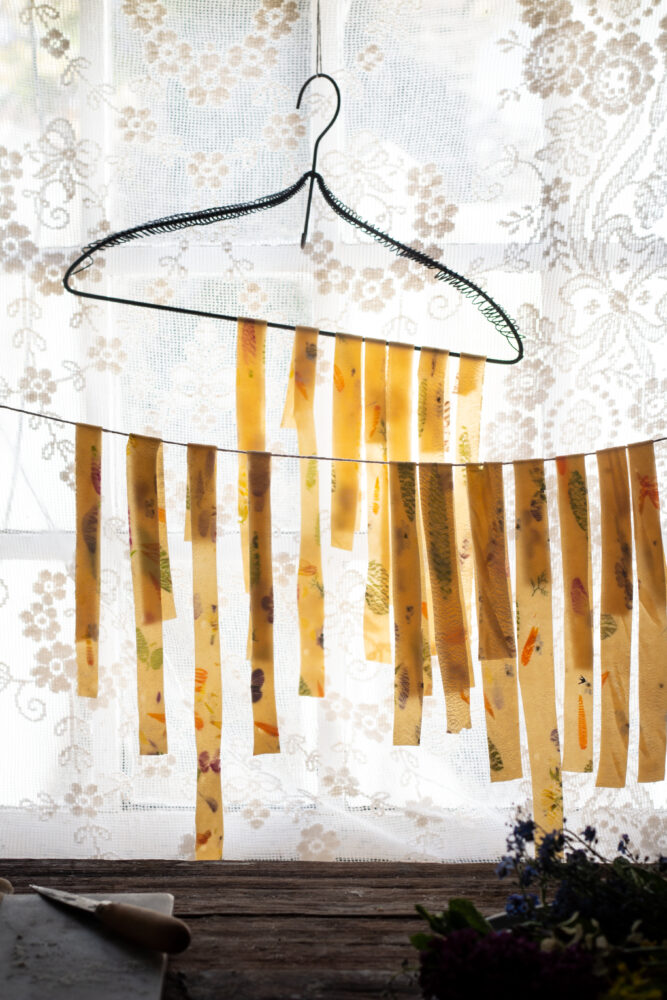
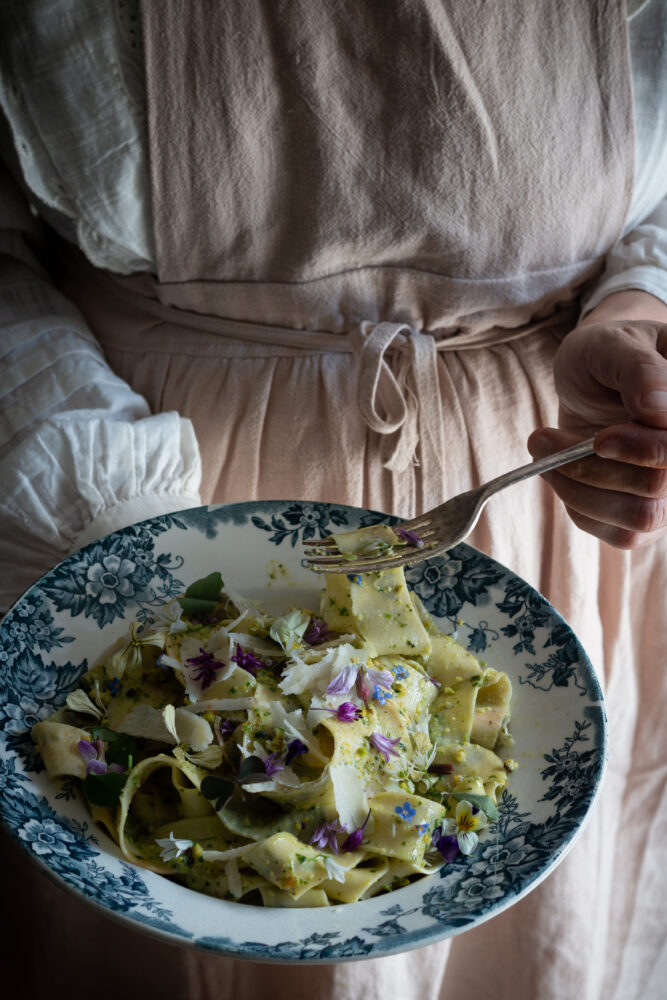

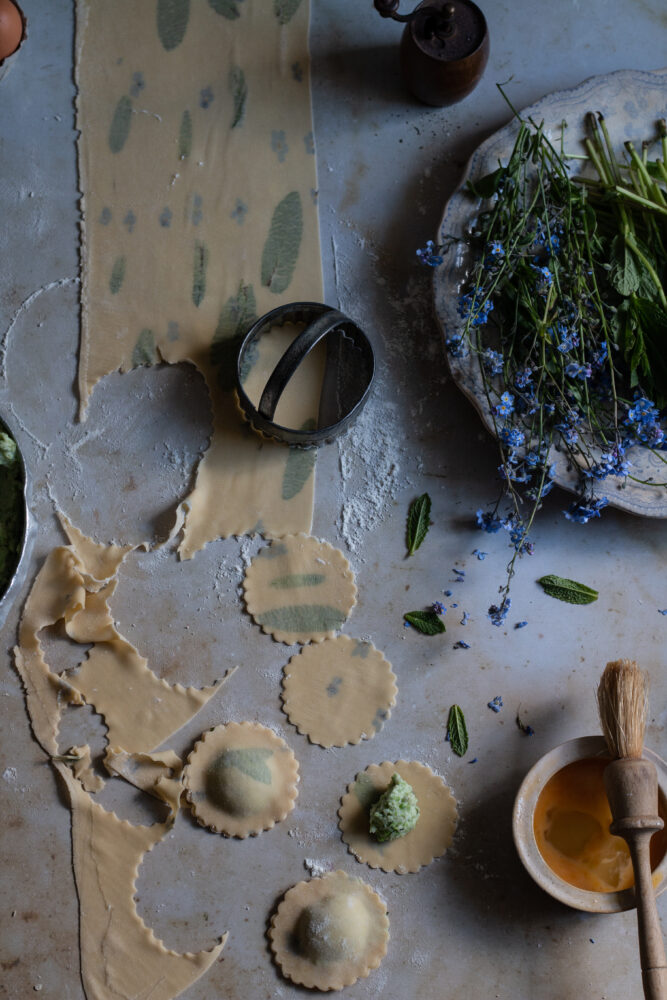

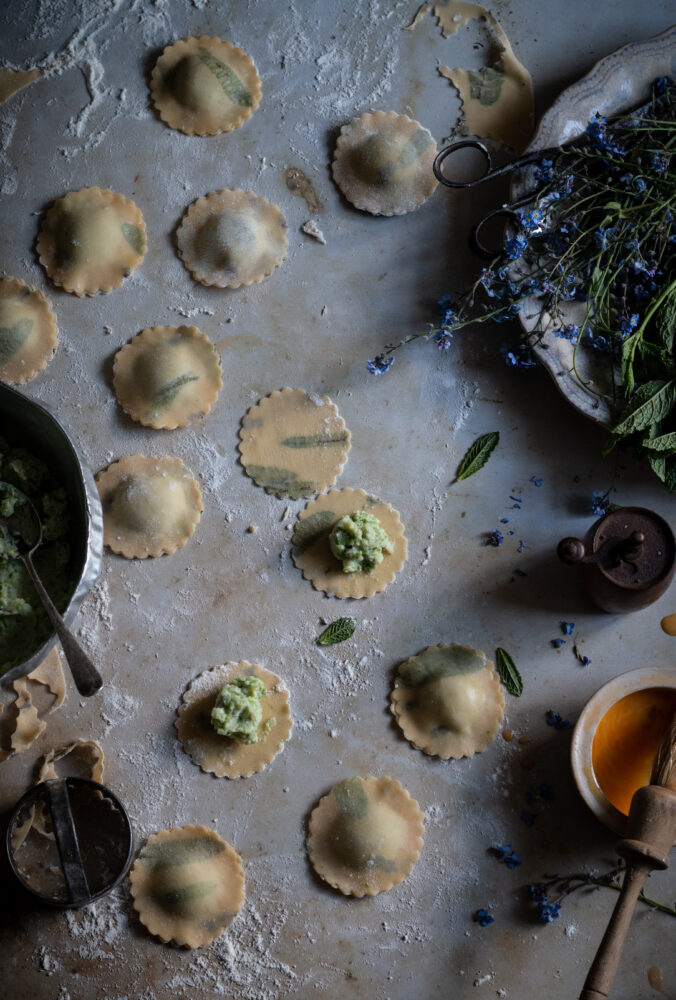
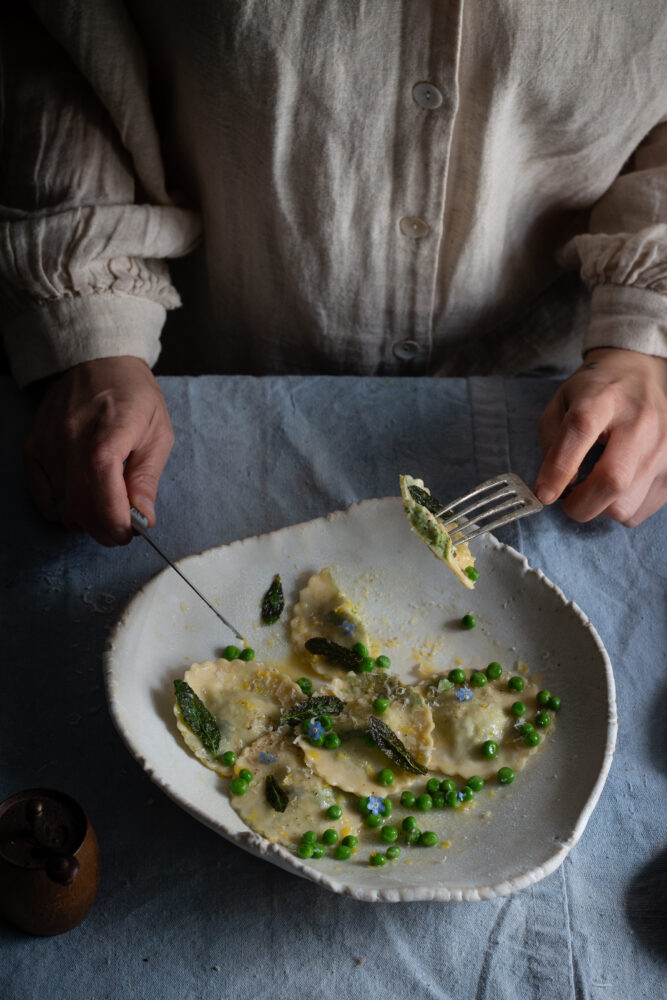

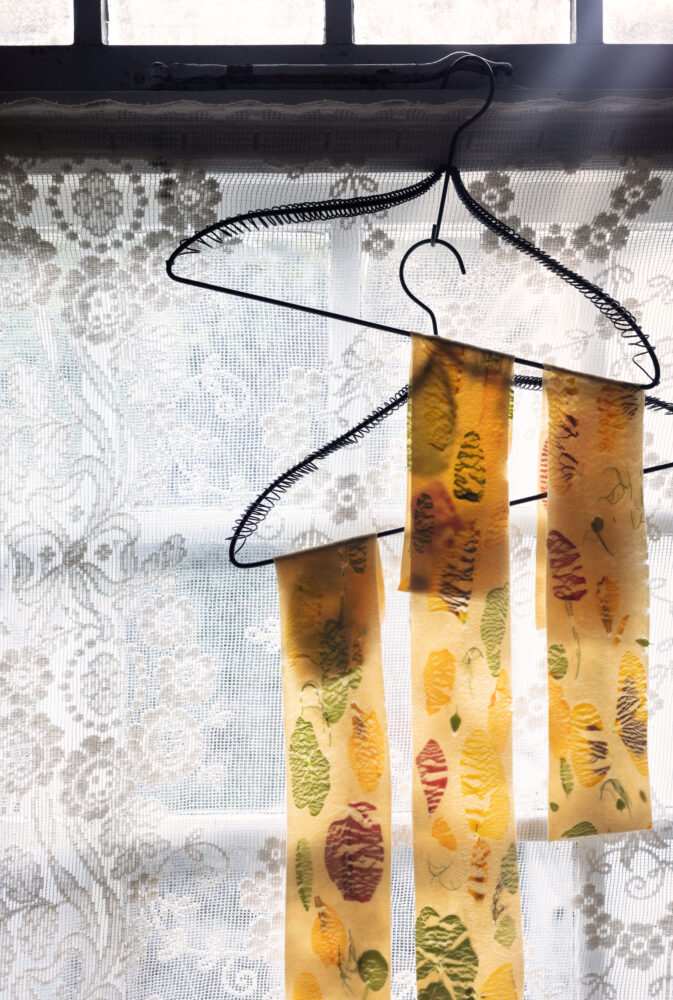
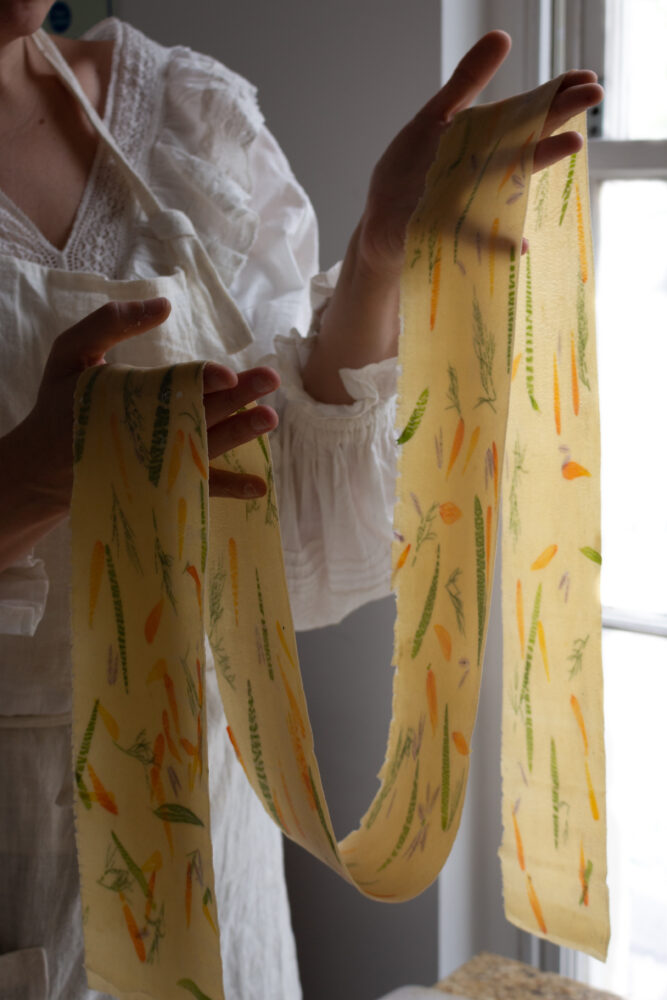
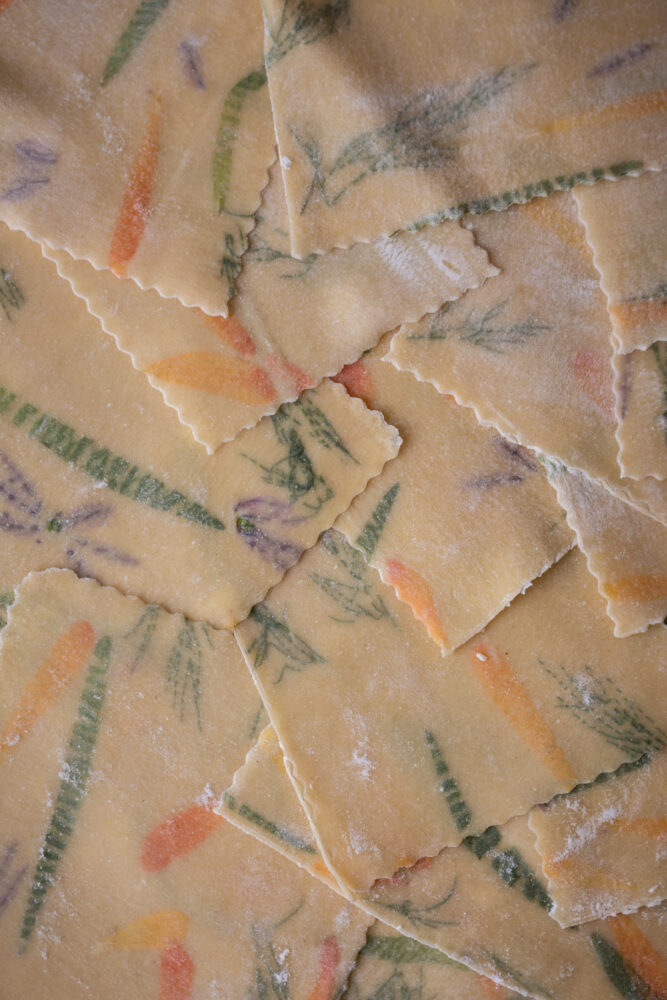
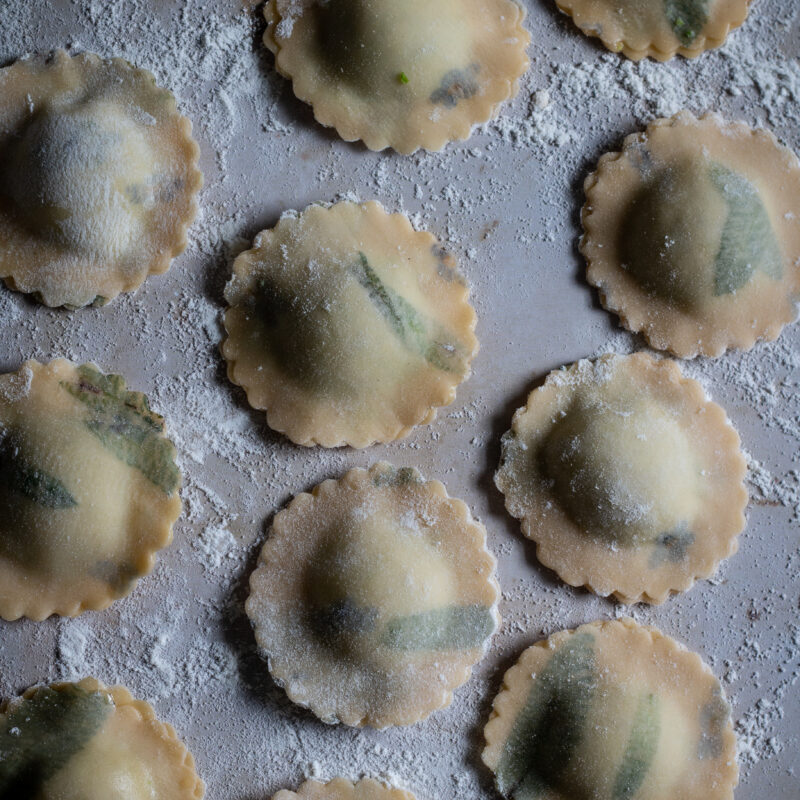
herb laminated ravioli filled with new potato, pea, mint and ricotta
Equipment
- Pasta machine
- circle pastry cutter
- pastry brush
- food processor
Ingredients
For the dough
- 300 grams tippo 00 flour
- 3 eggs
- small mint leaves and forget me not flowers
For the filling
- 300 grams new potatoes
- 250 grams ricotta cheese
- 150 grams peas
- small Handful of mint leaves approx 4 grams (15 to 20)
- 50 grams Parmesan
- 1 tsp balsamic vinegar
- salt and pepper to season
Instructions
- Preheat oven to 180c and place potatoes on a baking dish and roast for 1 hour or until soft, mean while make pasta dough,To make do, sift the flour on the table into a mound, and using your hands make a well in the centre so it is like a little volcano. Then crack the eggs into the centre and with a fork start mixing the eggs. Mix it until a paste is formed then start bringing in a bit of flour from around the edge a little at a time until its combined, then use your hands to mix the rest and knead it into a ball. You can add more flour if the dough is too sticky or a few drops of water if it’s too dry.Knead the dough with clean dry hands using the heel of your hand, basically as you would with bread. Working the dough for about 10 minutes until it is smooth to touch and elastic.
You can even knead it with the dough hook on your kitchen aid mixer if you are feeling really overwhelmed by the process of making it by hand, but I would suggest you try the hand mixed/kneaded method at least once or twice first so you can get used to how the pasta should look and feel. leave to rest for at least 20 minutes.Make fillingpeel off the potato skins and discard, add the potatoes in a food processor.
pour some boiling over over the peas, let them sit for a minute then drain and add the peas and the other ingredients into the food processor and pulse until combined.
Roll out the pasta sheet to as thin as you can so you have a nice thin long sheet. add the herbs and flowers and press on.
Space them out over half of the pasta sheet, and then fold the other half of dough over and press together. Turn the pasta machine back up to two thicknesses wider than the one it was last rolled through before you added the herbs/flowers and roll through, then turn it down to the next thickness and roll through again until it Is nice and thin.
Cut into circles and brush the edges with a beaten egg. Add filling and seal. Boil a pan of water and add some salt then boil for 3 minutes. Meanwhile in a pan add some oil and fry some mint leaves until crispy. Remove from pan and place on a paper towel until needed. add 100g butter. 50g peas and a tsp of freshly grated lemon zest in the pan and melt butter. Add the ravioli to pan to coat in butter and serve topped with the crispy mint, salt, pepper and cheese
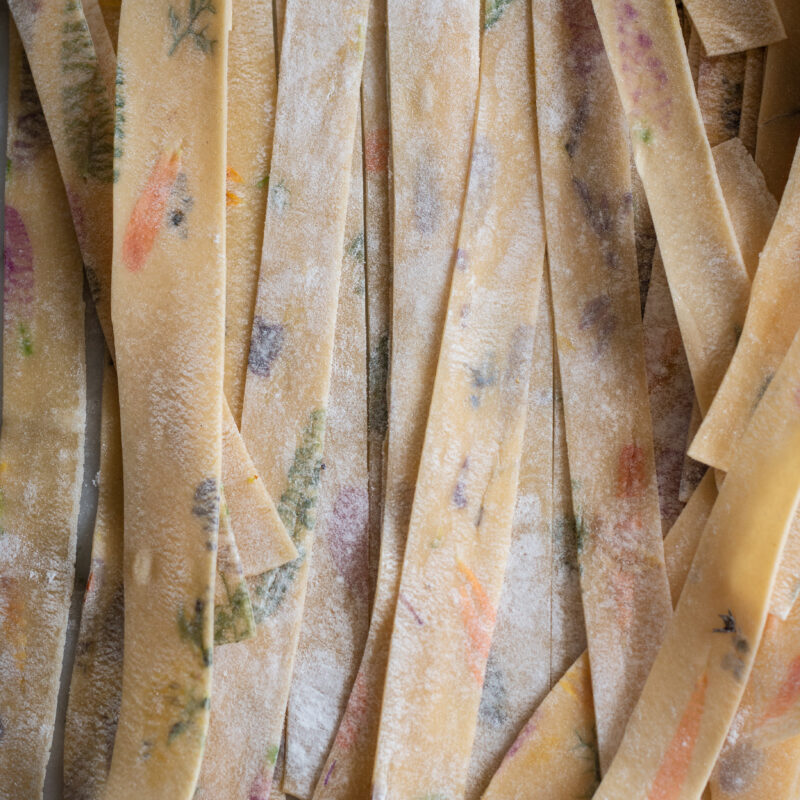
Edible flower pasta with pea shoot and pistachio pesto
Equipment
- Pasta machine
- food processor
Ingredients
For the dough
- 300 grams tippo 00 flour
- 3 eggs
- edible flowers and small basil leaves ie Calendula, pansy, cornflower, Dianthus
For the pesto
- 80 grams shelled pistachios toasted
- large handful of pea shoots
- 20 basil leaves
- 4 tbsp olive oil extra virgin
- 60 grams grated Parmesan
- 2 tbsp lemon juice
- 2 cloves of garlic
- salt and pepper
Instructions
- To make pasta, sift the flour on the table into a mound, make a well in the centre. crack the eggs in and mix with a fork. Mix it until a paste is formed then start bringing in a bit of flour from around the edge a little at a time until its combined, then use your hands to mix the rest and knead it into a ball. Let rest for 20 mins covered.
Roll out the pasta sheet to as thin as you can using a pasta rolling machine. add the herbs and flowers and press on.
Space them out over half of the pasta sheet, remembering that they will stretch and change size and then fold the other half of dough over and press together. Turn the pasta machine back up to two thicknesses wider than the one it was last rolled through before you added the herbs/flowers and roll through, then turn it down to the next thickness and roll through again until it Is nice and thin. Cut into strips.
Boil a pan of salted water and cook for about three minutes. Meanwhile add pesto and a bit more oil in a pan. Once pasta is cooked add to the pan of pesto and add a small ladle of the cooking water. Serve with grated cheese and more flower petals
To make pestoadd all the ingredients in a food processor until finely chopped.
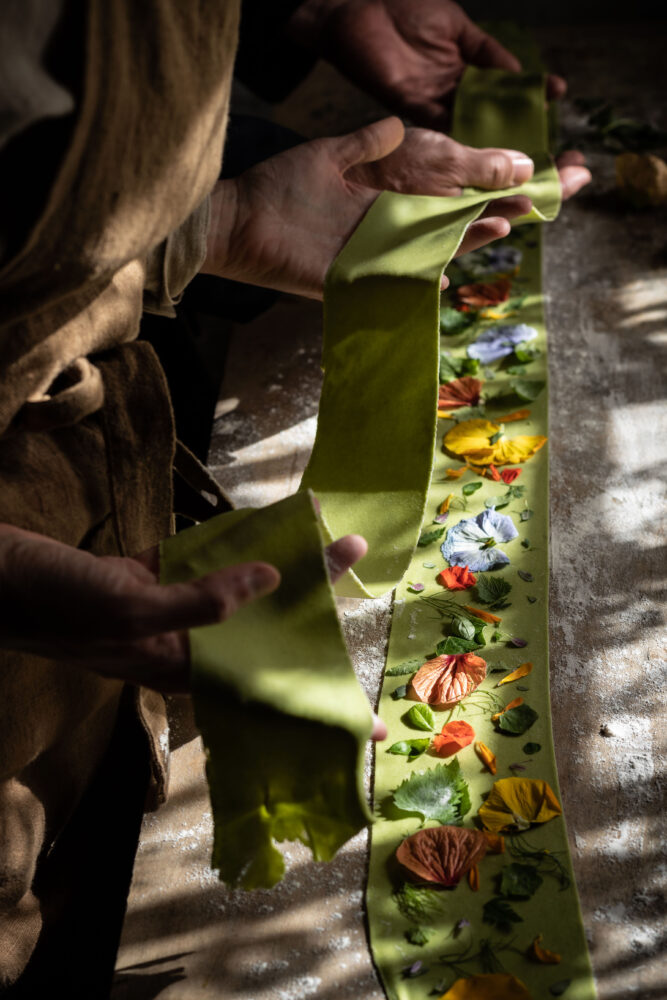
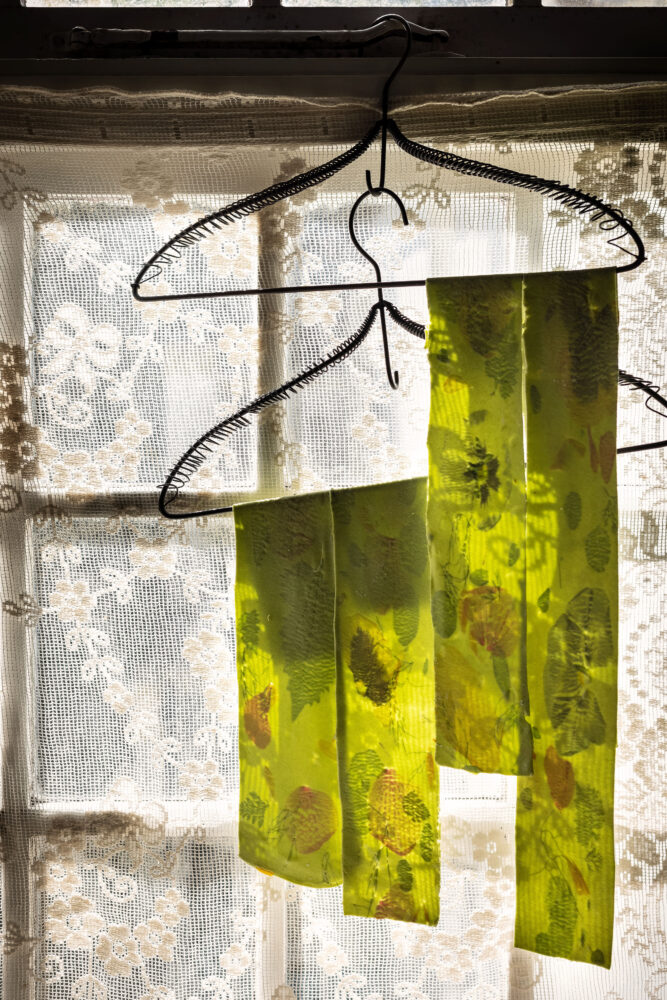
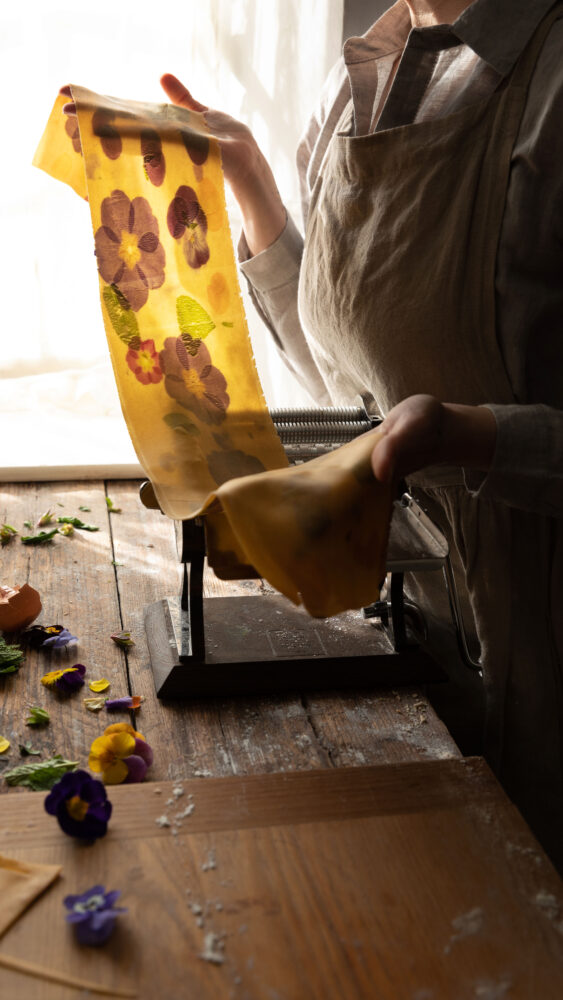
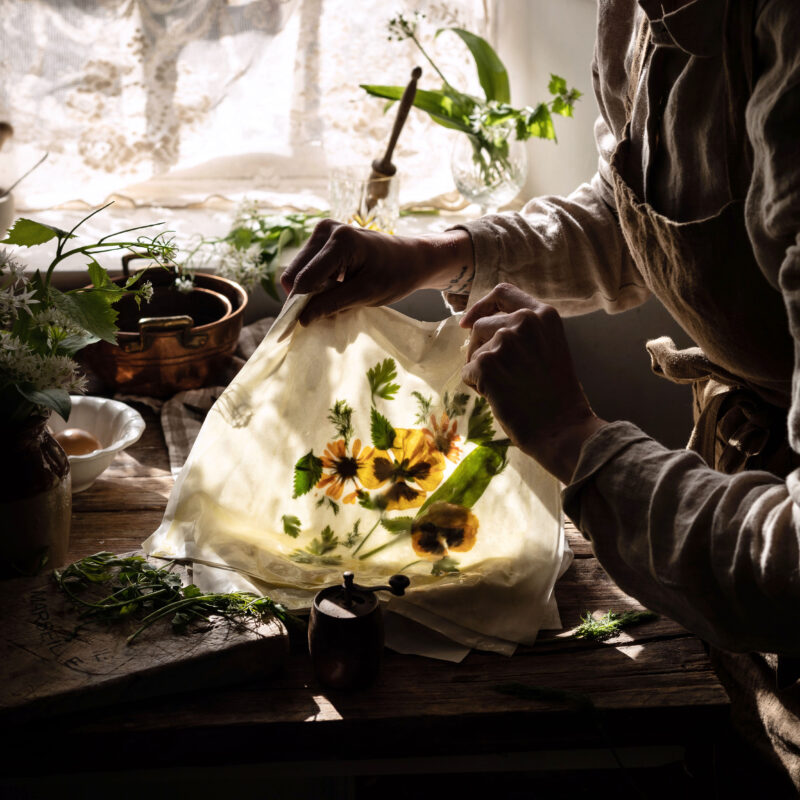

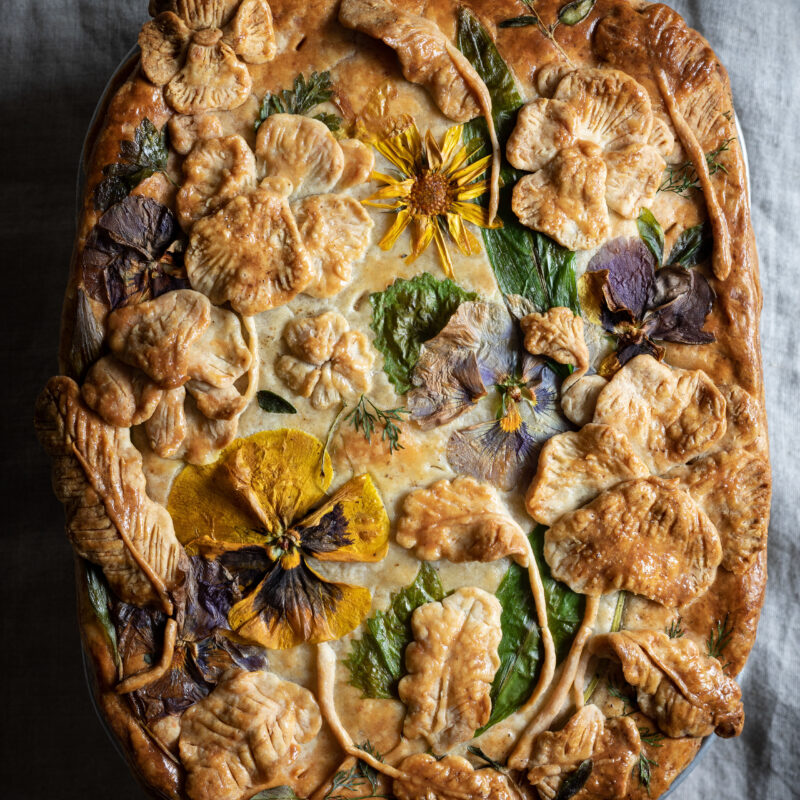


I simply can’t get enough of these pastas, they’re just so stunning!!!
thank you ruth xxxxx
This is gorgeous! Thank you!:^)
thank you xx
These are works of art! I have made homemade pasta before, whjich is really delicious, but you have brought it to a whole new level! Thank you so much for sharing! I am inspired…
thank you so much x
So Beautiful and such an inspiration for next years garden herbs and flowers. A new challenge to look forward to~ Thank you
thank you so much xx
Beautiful! I would love to make this and give it as a gift, but can I hang dry the pasta and it still be okay to eat later with all of the other fresh herbs/flowers in it? Or is it best eaten fresh?
i think the herbs may not last very well for more than a few days, i haven’t tried drying it out for longer than 2 or three days with herbs in x
Enchanting! As if Maira Kalman illustrated pasta…
thank you so much amy x
Unbelievably beautiful – so going to post to my insta – will tag you in – of course @callypalmertrends
thank you x
I can’t wait to try making beautiful pasta with edible flowers and herbs.. I bet squash blossoms would be so delicious in pasta as well. I think it’s delicate enough, don’t you?!
cheers,
yes they work well if you remove the stamens x
Your photos are stunning and this idea is amazing! Thank you so much for sharing
thank you x
Your pictures are just stunningly beautiful! So romantic and almost etherial in quality. I would love to try my hand at making this. I am curious as to what it looks like cooked, though – it is a little hard to make out in the photos of the finished dishes because of the additional ingredients and fresh flowers on top of the pasta. Could you provide one or two photos of cooked pasta with no added elements? That would be so much appreciated. Thanks!
ok, i will see what i can do, if i photograph the finished dish i usually photograph it as i would serve it with sauce but i will photograph it once its drained in the colander next time before i add sauce
Can this pasta be made in advance and frozen? I often freeze plain pasta with great results.
yes you can free it x